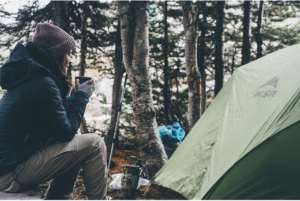Heading out into the wild and spending time with nature is one of the best things we can do as humans. We reconnect with nature and give ourselves the ability to recharge and reset our batteries. These trips can be anything from one night to a few days to a month in the wild, depending on your level of adventure. Being in the wild is a little different to just simple camping, you have to have your wits about you and understand the dangers that come with being away from any help.

Sure, you can have your phone on you but the chance of it having signal is slim to none. If you’re heading out for the first time then it’s best to keep your trip short and learn the ways of the wild. Here we take a look at some tips that could save your life if you find yourself in trouble.
Learn How To Start A Fire
For starters, let’s look at the most basic of survival techniques. Starting a fire is one of the best ways you can keep yourself alive. It keeps you warm during those awfully cold nights, especially if it’s unexpected and you haven’t packed the right clothes, you can dry any clothes that might have been drenched in the day, not to mention the fact you can cook over it. If you don’t know how to start a fire in the wild without the use of matches then the advice would strongly lean towards learning before you start your journey. Practice in your back yard until you have the hang of things.
Always Have A Knife To Hand
One of the best tools to have in the wild is a knife. It’s something that will save your life in more ways than you realize. There are multiple knives on the market to look at but it’s important to know and understand the reasons you’re using it. It’s all well and good having a knife in your cutlery set but it isn’t going to be able to perform the tasks that will present themselves when on an excursion.
A multi-use knife is the best to start with, you will be able to get yourself out of sticky situations, gut any animals you catch ready to cook over the fire, and defend yourself against attack (predominantly from animals). Looking at this useful guide will give you an idea of the different types of knives available and what they are used for. You might be at a level already where you have a multi-use knife so it could be time to invest in something a little more use-specific.
Learn Where To Camp
Knowing where to set your camp is survival 101. Find an opening in some trees when camping in the forest, preferably uphill from any water and away from any potential danger (look for animal droppings to see if they are fresh). Try and have an area for a fire and a source of water reasonably close, you just don’t want to be right next to the waterfront. If there is any danger of bears then it’s wise to hang all food high up in a tree away so they can’t smell it when walking around. Choosing your campsite is an important stage, don’t rush to the first one you see.
Get The Proper Equipment
There’s no excuse for having poor equipment when camping in the wild. A decent sleeping bag is a must as it’s the thing that’s going to keep you warm during the cold nights. A tent is somewhat optional as you can create shelter when out and about but it’s best to have one in the backpack just in case the areas you’re in don’t offer the chance to build.

Talking of backpacks, this is the one thing that’s going to hold all of your things so it’s definitely something you’re going to need to invest in, don’t cheap out, and end up carrying your things in your arms for the duration of the trip. If you’re serious about wild camping then invest as much as you can in your equipment, it might save your life.
Learn How To Read A Map & Compass
You can’t rely on your phone for everything. This is a rule everyone on the planet needs to learn but more so when in the wild. A map and compass are basic survival and navigational tools. Learn to read these and you’ll be able to navigate your way through even the densest of forests. If you’re unaware of how to use these bits of equipment then you can either take a course or look online for some direction. Don’t head into the wild without knowing how to use this equipment.
Carry Two Sets Of Clothes
If you’re out on your own or with a few people you might think only one set of clothes will save you weight in the backpack and will be easier to maintain. This isn’t the case. You should always have two sets of clothes on you. One for dry wear and one for anything wet. Whenever you’re in your wet clothes, as soon as the day is done change out into your dry clothes and hang your wet ones over a fire. Being cold and wet can lead to some serious illness.
Being in the wild is amazing, it resets your brain and gives you a chance to truly experience nature. If you’re in a situation to head out then do it, take the time to have an amazing adventure. Remember these tips and you’ll be well on your way to being a nature expert.

